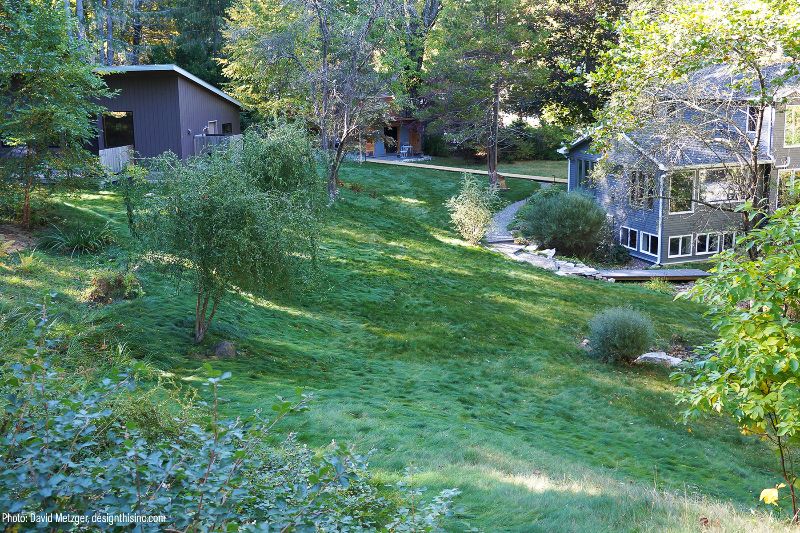No Mow Grass Offers Alternative to High-Cost, High-Maintenance Lawn Care
| . Posted in News - 5 Comments
By Eric Weld, MassLandLords, Inc.
More and more property owners are choosing a product called “no mow grass” for their lawns, here in Massachusetts and throughout the country, as a way to save money and time spent on lawn care while lightening environmental impact.

No mow grass seeds sprout into lush, rich green lawns that require only occasional mowing (image courtesy of Prarie Nursery, Inc.)
No mow grass is a low maintenance lawn alternative that mixes together several slow growth grass seeds that sprout into lush lawns needing mowing only a couple times per year depending on preference. The term “no mow grass” describes a range of seed blends that grow slower than typical lawn mixes, including fine fescues, buffalo grass, zoysia and clover.
The savings can be substantial.
Massachusetts property owners spend an average of $63 to have a half-acre lawn mowed every other week, according to statistics compiled by LawnStarter. That can add up to more than $800 a year, and that doesn’t include add-ons like fertilization and increased water bills.
For landlords with multiple properties, that average cost increases in proportion with the number of lawns needing regular maintenance. DIY landlords can shave savings off the lawn care price tag but it’ll cost time—as much as several hours a week during heavy growth months of April through July.
Imagine trimming that lawn care budget down to a couple of mows per year with no need for fertilizing and watering. A switch to no mow grass could save more than $650 per year per property on mowing alone.
The savings in money and time may be a large part of the explanation for an increase in recent years in slow growth grass mixes used in New England, such as white clover and several varieties of fescues.
John Cunningham, a lawn and garden manager at Mahoney’s Garden Center’s Winchester, MA, store, recently told MassLandlords there has been an uptick in slow growing lawn mixes in the past decade, particularly a product named Black Beauty, which is a blend of three tall fescues.
“A lot of people really like this stuff,” he said. “It’s been kind of a big hit. Also, we do see quite a few people looking for micro-clover,” another slow-growing lawn alternative.
In addition to the budget and time savings, Cunningham points out, many homeowners prefer the slow-growing grasses for their lighter environmental impact, such as lower water usage, no fertilizer added to the soil, and a reduction in carbon emissions with less mowing.

No mow grass seeds sprout into lush, green lawns (image courtesy of Prarie Nursery, Inc.)
Mass. Grass
The type of grass you have on your lawn depends largely on your local climate. Massachusetts’ long cold winters and hot, humid summers require a somewhat hardier grass blend than southern, temperate climes.
Kentucky Bluegrass is the most common cool season grass and proliferates lawns throughout Massachusetts and the Northeast. Many prefer it for its rich, green hue, its even growth pattern and tendency to fill in bare areas. But Kentucky Bluegrass requires irrigation during hot peaks, needs regular fertilizer, and does not fare well in shady zones.
No mow grass offers an equally hardy alternative without the constant need of attention and resources—and no need for fertilizer or watering.
Prarie Nursery, Inc., a landscape retailer in Westfield, WI, is a top seller of no mow grass. President Nick Diboll assures that Massachusetts lies solidly within the “no mow zone” where slow growing grass varieties can thrive. His custom blend of slow growth fescue grasses takes well to the variant New England climates with low groundwater at times, shady areas and millions of rocks underground for roots to grow through and around.

No mow lawns require mowing as little as twice a year depending on preferences (photo by David Metzger, courtesy of Prarie Nursery, Inc.)
When to Plant
The most optimal time to plant no mow grass is in the early fall, notes Diboll, but planting can also be effective in the spring before heavy rain as long as competing weed growth is monitored closely.
Switching a lawn from a typical bluegrass, for example, to a slow growth seed mix requires removing existing grass first to avoid competing growth.
Despite the upfront investment, however, Diboll emphasizes no mow grass is very cost-effective in the long run, especially when gas, fertilizer and increased water bills are taken into account.




